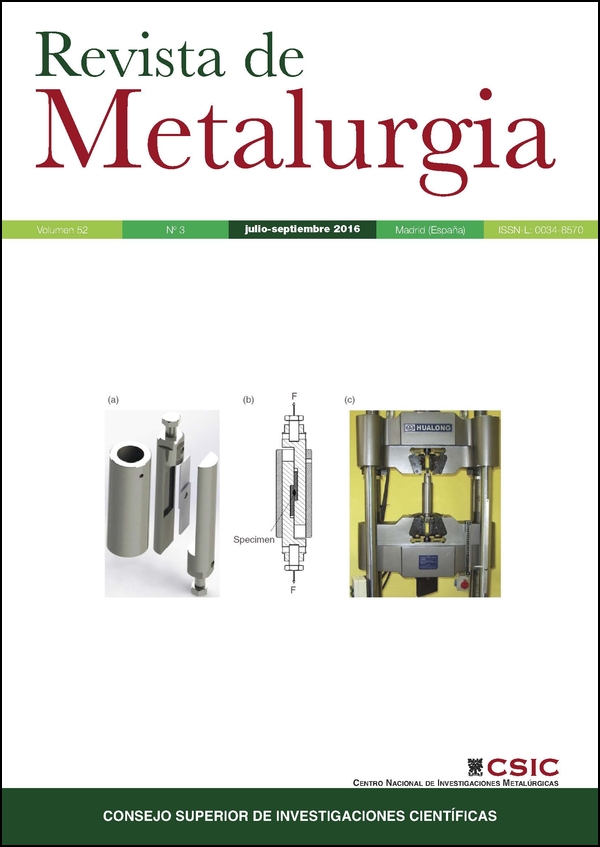Design of barrier-biomimetic TEOS-GPTMS multilayer coatings deposited on the Elektron 21 magnesium alloy with potential application in the manufacture of orthopaedic implants
DOI:
https://doi.org/10.3989/revmetalm.075Keywords:
Bioactivity, Biomaterials, Corrosion, Magnesium alloys, Sol-gel coatingsAbstract
In the present work, barrier-biomimetic multilayer coatings were synthesized via sol-gel on the commercial Elektron 21 magnesium alloy, with potential interest in the fabrication of orthopaedic temporal implants. Sol-gel synthesis was carried out from a mixture of inorganic and organic precursors, TEOS and GPTMS. Two different sols were prepared: sols employed for the design of barrier coatings (named GT) which function were to protect the magnesium alloy against corrosion; and sols containing additionally calcium nitrate (named GTCa), in different concentrations, for the design of the biomimetic coatings, which were deposited over the GT coating. The results confirmed that the GT coatings enhanced the corrosion resistance of the base alloy in Hank solution, reducing the corrosion current density in about two orders of magnitude. Further, the presence of Ca(II) in GTCa coatings promoted the formation of discontinuous film of hydroxyapatite on the surface, indicating that those coatings exhibit bioactive properties.
Downloads
References
Ascencio, M., Pekguleryuz, M., Omanovic, S. (2014). An investigation of the corrosion mechanisms of WE43 Mg alloy in a modificated simulated body fluid solution: The influence of immersion time. Corros. Sci. 87, 489–503. http://dx.doi.org/10.1016/j.corsci.2014.07.015
Ballarre, J., Manjubala, I., Schreiner, W., Orellano, J., Fratzl, P., Ceré, S. (2010). Improving the osteointegration and bone–implant interface by incorporation of bioactive particles in sol–gel coatings of stainless steel implants. Acta Biomater. 6 (4), 1601–1609. http://dx.doi.org/10.1016/j.actbio.2009.10.015 PMid:19835999
Carbajal, L., Serena, S., Caballero, A., Saínz, M.A., Detsch, R., Boccaccini, A.R. (2014). Role of ZnO additions on the ?/? phase relation in TCP based materials: Phase stability, properties, dissolution and biological response. J. Eur. Ceram. Soc. 34 (5), 1375–1385. http://dx.doi.org/10.1016/j.jeurceramsoc.2013.11.010
Carboneras, M., García-Alonso, M.C., Escudero, M.L. (2011). Biodegradation kinetics of modified magnesium-based materials in cell culture medium. Corros. Sci. 53 (4), 1433-1439. http://dx.doi.org/10.1016/j.corsci.2011.01.014
Chen, Q., Thouas, G. (2015). Metallic implant biomaterials. Mater. Sci. Eng. R. 87, 1–57. http://dx.doi.org/10.1016/j.mser.2014.10.001
Contreras, G., Nieves, C., Remolina, E., Hernández, C., Liu, Z., Coy, A., Viejo, F. (2015). Síntesis y evaluación de recubrimientos híbridos sol-gel base: TEOS: GPTMS: APTES para la protección contra la corrosión de la aleación AA2124-T4 y su material compuesto AA2124-T4/25%SiCp. Rev. LatinAm. Metal. Mat. 35 (2), 222–236.
Díaz, U., Cantín, A., García, T., Corma, A. (2008). Layered hybrid materials with nanotechnological applications: use of disilane precursors as pillaring agents. Stud. Surf. Sci. Catal. 174, 337–340. http://dx.doi.org/10.1016/S0167-2991(08)80211-X
Dorozhkin, S. (2014). Calcium orthophosphate coatings in magnesium and its biodegradable alloys. Acta Biomater. 10 (7), 2919–2934. http://dx.doi.org/10.1016/j.actbio.2014.02.026 PMid:24607420
Ettarh, C., Galwey, A. (1996). A kinetic and mechanistic study of the thermal decomposition of calcium nitrate. Thermochim. Acta 288 (1–2), 203–219. http://dx.doi.org/10.1016/S0040-6031(96)03052-3
Fan, W., Du, H., An, Y., Guo, C., Wei, Y., Hou, L. (2015). Fabrication and characterization of hydroxyapatite-methylcellulose composite coating on the surface of AZ31 magnesium alloy. Mater. Lett. 152, 32–35. http://dx.doi.org/10.1016/j.matlet.2015.03.068
Fathi, M., Doostmohammadi, A. (2009). Bioactive glass nanopowder and bioglass coating for biocompatibility improvement of metallic implant. J. Mater. Process. Tech. 209 (3), 1385–1391. http://dx.doi.org/10.1016/j.jmatprotec.2008.03.051
Gu, X., Zheng, Y., Cheng, Y., Zhong, S., Xi, T. (2009). In vitro corrosion and biocompatibility of binary magnesium alloys. Biomaterials 30 (4), 484–498. http://dx.doi.org/10.1016/j.biomaterials.2008.10.021 PMid:19000636
Han, Y., Taylor, A., Mantle, M., Knowles, K. (2007). Sol–gel-derived organic–inorganic hybrid materials. J. Non-Cryst. Solids 353 (3), 313–320. http://dx.doi.org/10.1016/j.jnoncrysol.2006.05.042
Jones, J.R. (2013). Review of bioactive glass: From Hench to hybrids. Acta Biomater. 9 (1), 4457–4486. http://dx.doi.org/10.1016/j.actbio.2012.08.023 PMid:22922331
Kielbus, A. (2007). Microstructure and mechanical properties of Elektron 21 alloy after heat treatment. JAMME 20 (1–2), 127–130.
Kokubo, T., Takadama, H. (2006). How useful is SBF in predicting in vivo bone bioactivity?. Biomaterials 27 (15), 2907–2915. http://dx.doi.org/10.1016/j.biomaterials.2006.01.017 PMid:16448693
Liu, D-M., Yang, Q., Troczynski, T. (2002). Sol-gel hydroxyapatite coatings on stainless steel substrates. Biomaterials 23 (3), 691–698. http://dx.doi.org/10.1016/S0142-9612(01)00157-0
Maruyama, N., Mori, D., Hiromoto, S., Nakamura, M. (2011). Fatigue strength of 316L-type stainless steel in simulated body fluids. Corros. Sci. 53 (6), 2222–2227. http://dx.doi.org/10.1016/j.corsci.2011.03.004
Mohseni, E., Zalnezhad, E., Bushroa, A.R. (2014). Comparative investigation on the adhesion of hydroxyapatite coating on Ti-6Al-4V implante: A review. Int. J. Adhes. Adhes. 48, 238–257. http://dx.doi.org/10.1016/j.ijadhadh.2013.09.030
Murillo-Gutiérrez, N.V., Ansart, F., Bonino, J-P., Kunst, S.R., Malfatti, C.F. (2014). Architectural optimization of an epoxy-based hybrid sol-gel coating for the corrosion protection of a cast Elektron 21 magnesium alloy. Appl. Surf. Sci. 309, 62–73. http://dx.doi.org/10.1016/j.apsusc.2014.04.169
Shadanbaz, S., Dias, G. (2012). Calcium phosphate coating on magnesium alloys for biomedical applications: A review. Acta Biomater. 8 (1), 20–30. http://dx.doi.org/10.1016/j.actbio.2011.10.016 PMid:22040686
Sumita, M., Hanawa, T., Teoh, S.H. (2004). Development of nitrogen-containing nickel-free austenitic stainless steels for metallic biomaterials: Review. Mat. Sci. Eng. C-Biomim. 24 (6–8), 753–760. http://dx.doi.org/10.1016/j.msec.2004.08.030
Tan, L., Wang, Q., Geng, F., Xi, X., Qiu, J., Yang, K. (2010). Preparation and characterization of Ca-P coating on AZ31 magnesium alloy. T. Nonferr. Metal. Soc. 20 (2), 648–654. http://dx.doi.org/10.1016/S1003-6326(10)60555-9
Varela, J., Reyes-Cervantes, E., Rubio-Rosas, E. (2011). Crecimiento en fluidos fisiológico simulado de hidroxiapatita sobre películas de PMMA-sílice-CaO. Superficies y Vascío 24 (3), 92–95.
Witte, F., Hort, N., Vogt, C., Cohen, S., Kainer, K., Willumeit, R., Feyerabend, F. (2008). Degradable biomaterials based on magnesium corrosion. Curr. Opin. Solid St. M. 12 (5–6), 63–72. http://dx.doi.org/10.1016/j.cossms.2009.04.001
Xin, R., Leng, Y., Chen, J., Zhang, Q. (2005). A comparative study of calcium phosphate formation on bioceramics in vitro and in vivo. Biomaterials 26 (33), 6477–6486. http://dx.doi.org/10.1016/j.biomaterials.2005.04.028 PMid:15992923
Xin, Y., Hu, T., Chu, P.K. (2011). In vitro studies of biomedical magnesium alloys in simulated physiological environment: A review. Acta Biomater. 7 (4), 1452–1459. http://dx.doi.org/10.1016/j.actbio.2010.12.004 PMid:21145436
Zheng, S., Li, J. (2010). Inorganic-organic sol gel hybrid coatings for corrosion protection of metals. J. Sol-Gel Sci. Techn. 54 (2), 174–187. http://dx.doi.org/10.1007/s10971-010-2173-1
Zomorodian, A., Brusciotti, F., Fernandes, A., Carmezim, M.J., Moura e Silva, T., Fernandes, J.C.S., Montemor, M.F. (2012). Anti-corrosion performance of a new silane coating for corrosion protection of AZ31 magnesium alloy in Hank's solution. Surf. Coat. Tech. 206 (21), 4368–4375. http://dx.doi.org/10.1016/j.surfcoat.2012.04.061
Published
How to Cite
Issue
Section
License
Copyright (c) 2016 Consejo Superior de Investigaciones Científicas (CSIC)

This work is licensed under a Creative Commons Attribution 4.0 International License.
© CSIC. Manuscripts published in both the printed and online versions of this Journal are the property of Consejo Superior de Investigaciones Científicas, and quoting this source is a requirement for any partial or full reproduction.
All contents of this electronic edition, except where otherwise noted, are distributed under a “Creative Commons Attribution 4.0 International” (CC BY 4.0) License. You may read the basic information and the legal text of the license. The indication of the CC BY 4.0 License must be expressly stated in this way when necessary.
Self-archiving in repositories, personal webpages or similar, of any version other than the published by the Editor, is not allowed.
















